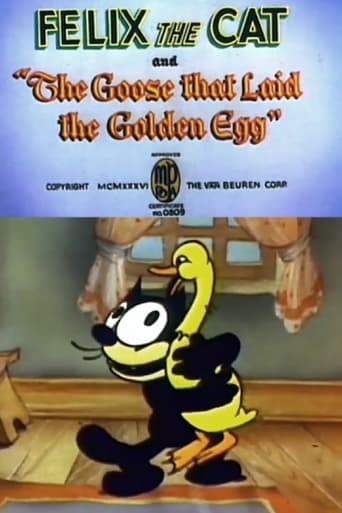

"The Goose That Laid the Golden Egg" is a 7-minute cartoon that has its 80th anniversary this year. Felix the Cat is probably mostly known for his black-and-white short films, in which he is a bit of a pioneer before the Golden Years of Animation, but he existed afterward too and this is his attempt at a transition. Not too successful in my opinion. This cartoon delivered almost more from a dramatic than comedic perspective. The locations and items used are interesting, but the comedy is almost non-existent or simply over so quickly that it does not stay in the mind. Maybe this character really works best with black-and-white silent films. I did not enjoy this short film here. Lacks completely the smartness that other films from that era had. Thumbs down.
... View MoreThe Goose That Laid the Golden Egg (1936) ** 1/2 (out of 4)Felix the Cat is in possession of a goose that can lay golden eggs so he has no problem sharing his wealth with the people of the community. Captain Kidd discovers this goose and steals it in hopes to give him riches so Felix must try and rescue his friend.As other reviewers have pointed out, this film was certainly meant to have an undertone in that people should be helping others during the Depression era. With that said, the movie manages to be quite entertaining thanks in large part to the animation and colors. I really loved the way the golden tone of the eggs looked and I especially enjoyed the design of the goose. There's a wonderful fight sequence at the end that helps keeping the acting moving along. There's certainly nothing ground-breaking here but it's an entertaining short.
... View MoreThis short is a definite commentary on the Depression more than anything else. Felix has started his own social welfare program--handing out free gold from his goose to all the people of his town. However, the jerk, Captain Kidd*, wants it all for himself and steals the amazing bird. So, it's up to Felix to rescue his pet and save the day.I am a fan of the early Felix the Cat cartoons. I am talking about the silent ones they made from 1919 to about 1929. The films were, more than anything else, fun--with a strange surrealistic style about them. Felix was a joker--and occasionally a bit of a jerk--and I liked it that way. Well, the series petered out in the talking picture era--mostly because the cartoons lost their zip. The surrealism was gone and the cartoons became dull. A few years after their initial demise, Van Beuren Studios attempted to revive the series. Now considering that they only made three Felix cartoons, you can pretty much guess what the public thought. As far as I am concerned, the public got it right. Although the Van Beuren cartoons looked a lot better (with color and really nice animation), they changed Felix--making him a nice-guy. The public didn't want a nice-guy--they wanted FELIX! And, even though there was a strong welfare component to this film, even Depression era folks didn't take to the films.So what is there to like about this film? Well, the animation is probably the best of the three Van Beuren films. Also, I liked how Felix caught up with the boat--that was something the old Felix would have done. But otherwise, it's just a pretty film with absolutely no humor about it at all...none.*It's interesting how movies often feature Captain Kidd. As a history teacher who taught about pirates, I think it's odd how he is often talked about when he was actually one of the most pathetic and unsuccessful pirates in history. He didn't even willingly become one! He served with the British Navy and was sent to capture pirates. However, his crew mutinied and forced him to piracy. His career as a pirate only lasted about a year or so--then was caught and, much later, executed.
... View MoreIn 1936 Felix the Cat was resurrected to the screen in three short animated films. This is one of them. In it, Felix, speaking audibly for the first time, must protect his goose who lays golden eggs for him from a band of pirates. The two other animated shorts produced in 1936 are "Neptune Nonsense" and "Bold King Cole." Besides talking for the first time, these three shorts also marked the first time that Felix was produced in color. One of the film's directors was Otto Mesmer, who also happened to be Felix's creator in 1919, though credit is also given to Pat Sullivan, the head of the studio that employed the young artist Mesmer. This is the era where Felix looks his best, and this is the second best of the three 1936 productions. "Neptune" is its superior, but this still is a splendid film for Felix fans of all ages!
... View More